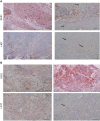Evaluation of the Expression of HER2 and c-KIT Proteins as Prognostic Markers in Superficial Bladder Urothelial Carcinoma
- PMID: 33981633
- PMCID: PMC8109022
- DOI: 10.2147/RRU.S296974
Evaluation of the Expression of HER2 and c-KIT Proteins as Prognostic Markers in Superficial Bladder Urothelial Carcinoma
Abstract
Background: The roles of c-KIT and HER2 protein expression in bladder cancer are still debated, and the prognostic value of these proteins as markers of tumor progression is inconclusive.
Objective: To assess the impact of HER2 and c-KIT protein expressions in the progression of non-muscle-invasive bladder cancer.
Methods: All patients undergoing transurethral resection of bladder tumors for non-muscle-invasive urothelial carcinoma, with standard regimen of BCG, between January 2017 and November 2019, were evaluated pathologically and immunohistochemically for HER1 and c-KIT proteins in urothelial carcinoma cells. Follow-up cystoscopy was performed for 100 patients every 3 months for the first 2-years and any recurred tumors were excised and examined pathologically, as well as stained for HER2 and c-KIT protein expression.
Results: HER2 and c-KIT positive expressions were detected in 49% and 38% of cases, respectively. After a mean follow-up of 26.4±7.2 months, the overall recurrence and progression rates were significantly correlated with overexpression of HER2 and c-KIT. In high-grade non-invasive muscle neoplasms, tumor cells showed weak expression for both HER2 and c-KIT proteins, but with progression to muscle-invasion, tumor cells strongly expressed HER2 and lost expression to c-KIT. In the multivariate model, overexpression of HER2 rather than c-KIT protein significantly predicted increased progression.
Conclusion: Recurrence and progression of non-muscle-invasive bladder cancer correlate with overexpression of HER2 and c-KIT proteins in tumor cells.
Keywords: HER2; c- KIT; non-muscle-invasive; urothelial carcinoma.
© 2021 Abdou Hassan et al.
Conflict of interest statement
None of the contributing authors have any conflict of interest, including specific financial interests or relationships and affiliations relevant to the subject matter or materials discussed in the manuscript.
Figures


References
-
- Brausi M, Collette L, Kurth K, et al.; EORTC Genito-Urinary Tract Cancer Collaborative Group. Variability in the recurrence rate at first follow-up cystoscopy after TUR in stage Ta T1 transitional cell carcinoma of the bladder: a combined analysis of seven EORTC studies. Eur Urol. 2002;41(5):523–531. doi:10.1016/S0302-2838(02)00068-4. - DOI - PubMed
LinkOut - more resources
Full Text Sources
Research Materials
Miscellaneous

